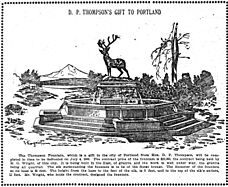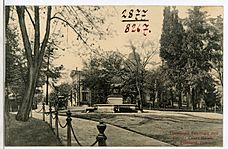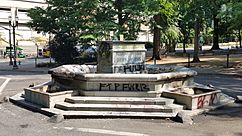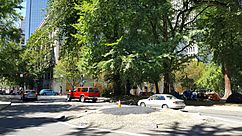Elk (sculpture) facts for kids
Quick facts for kids Elk |
|
|---|---|
| Elk Fountain, David P. Thompson Monument | |
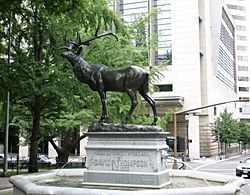
The sculpture in 2006
|
|
| Artist | Roland Hinton Perry (statue) H.G. Wright (fountain) |
| Year | 1900 |
| Type | Sculpture |
| Medium |
|
| Subject | Elk |
| Designation | Portland Historic Landmark |
| Condition | removed for assessment (July 2020) |
| Location | Portland, Oregon, United States |
| 45°30′57″N 122°40′39″W / 45.515721°N 122.677485°W | |
| Owner | Regional Arts & Culture Council |
The Elk statue, also known as the David P. Thompson Fountain, was a famous outdoor fountain and bronze sculpture in Portland, Oregon. An American artist named Roland Hinton Perry created it. The statue was given to the city of Portland in 1900. It was placed in the Plaza Blocks area of Downtown Portland. The statue is owned by the Regional Arts & Culture Council (RACC).
In July 2020, the area around the monument became a place for protests. Some fires were lit near the base of the fountain. Because of this, the bronze elk statue was taken away on July 2, 2020, to be cleaned and kept safe. The stone fountain part was removed on July 17, 2020. This happened after RACC found that the stone and basin of the fountain were badly damaged.
What the Elk Statue Looked Like
The Elk statue was located in Portland's Plaza Blocks. It stood between Chapman Square and Lownsdale Square. The artwork showed a bronze statue of an elk. The elk rested on a base made of granite. This base was inside an octagon-shaped pool.
The statue and its base were about 9 feet (2.7 meters) tall. The pool around it was about 3 feet 3 inches (1 meter) deep. It was also about 25 feet (7.6 meters) wide and 8 feet (2.4 meters) long.
The Elk Statue's Story
The Elk monument was designed by Roland Hinton Perry. He was also the sculptor for other famous works. These include the Court of Neptune Fountain at the Library of Congress. He also created Commonwealth, a statue on top of the Pennsylvania State Capitol.
The fountain and the bronze elk statue were a gift from David P. Thompson. He was a former mayor of Portland. He donated the statue in 1900. It was meant to remember the elk that used to live in the area.
The project cost $20,000. E.G. Wright oversaw the design and building. The fountain was made of Barre Granite. It was planned to be 25 feet (7.6 meters) wide and have an 8-foot (2.4 meters) tall base. Wright wanted to finish it by Fourth of July for a city carnival. However, there were delays. Trees had to be removed, Main Street needed widening, and city water pipes had to be connected.
The 6,800-pound (3,084 kg) Elk statue was put in place in late August 1900. The Thompson Fountain was finished in the first week of September 1900. A carnival by the Portland Elks Club started that week. The Oregonian newspaper told its readers that "this is not a carnival elk." The city said the Elks Club did not want to dedicate the statue. They thought it was "a monstrosity of art." A reporter in 2020 said that the statue might not have looked exactly like the elk found in Oregon. It did not look like an Olympic elk or a Rocky Mountain elk.
In 1974, the Thompson's Elk and the Plaza Blocks were named Historic Landmarks. This was done by the city's Historic Landmarks Commission. They called it the David P. Thompson Fountain.
The sculpture appeared in the 1991 film My Own Private Idaho. This movie was directed by Gus Van Sant. In the film, the elk was shown with a rider on it.
In 1993, the artwork was studied by the Smithsonian Institution's "Save Outdoor Sculpture!" program.
The Elk sculpture is also on the cover of the 2002 album The Mantle. This album is by the Portland band Agalloch.
Why the Elk Was Removed
The elk statue has been damaged many times over the years. It was damaged during the Occupy Portland protest in 2011. Its antlers were fixed in early 2012. In 2016, messages against Donald Trump were written on the statue.
On July 1, 2020, during the George Floyd protests, people lit fires in two planter boxes near the statue. This caused damage to the granite base of the sculpture. The Regional Arts & Culture Council (RACC) decided it was a safety risk. So, the city removed the bronze elk sculpture on July 2 to clean it. It was not damaged.
Later, RACC found that the stone and basin of the fountain were very damaged. Because of this, the fountain was removed on July 17. The future of the Elk fountain is still being decided. In late August 2020, the statue was being kept "safely in storage."


